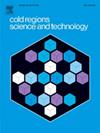Comparison of the applicability of Eulerian methods for snow protection engineering and evaluation of the protective performance of typical collector fences
IF 3.8
2区 工程技术
Q1 ENGINEERING, CIVIL
引用次数: 0
Abstract
This study conducts the numerical implementation and solver development of four sub-models based on the Eulerian method with OpenFOAM software, which have been used in prior numerical simulations of wind-induced snow drifting. Verification studies are conducted on the sub-models to assess their applicability and limitations in the field of snow protection engineering. Wind tunnel experiments conducted on a snow fence in Hokkaido serve as a benchmark for these evaluations. A comparative analysis indicates that the mixture multiphase flow model, incorporating two-way coupling between phases, adeptly reproduces snow distribution around snow fences. In contrast, scalar transport models, which consider one-way coupling, are suitable only for studying snowdrifts in the early stage of protection engineering with relatively low snow concentrations. Efforts to integrate phase coupling effects by introducing source terms into the turbulence model are found to be unsatisfactory. By employing a mixture multiphase flow model, this study explores the effects of six typical collector fences on wind-induced snow drifting in road cuttings. Comparative analyses are performed on several aspects, including the morphology of the cutting flow field, snow distribution, snow concentration, and the protective efficacy of the fences, with the aim to evaluate the effectiveness and applicability of snow fences. The results show that collector fences exhibit effective snow protection capabilities for road cuttings. The snow fence in Hokkaido, wind fence, and the snow fence in Wyoming demonstrate the highest protection efficiency among the analyzed collector fences, indicating superior snowdrift control effectiveness within the cuttings. The protective mechanism of collector fences is to decrease the snow transport rate within the saltation layer at the entrance of the protected area, leading to a notable decrease in snow concentration within the saltation layer in the cuttings. This study offers valuable insights and suggestions for snow protection engineering in road cuttings.
求助全文
约1分钟内获得全文
求助全文
来源期刊

Cold Regions Science and Technology
工程技术-地球科学综合
CiteScore
7.40
自引率
12.20%
发文量
209
审稿时长
4.9 months
期刊介绍:
Cold Regions Science and Technology is an international journal dealing with the science and technical problems of cold environments in both the polar regions and more temperate locations. It includes fundamental aspects of cryospheric sciences which have applications for cold regions problems as well as engineering topics which relate to the cryosphere.
Emphasis is given to applied science with broad coverage of the physical and mechanical aspects of ice (including glaciers and sea ice), snow and snow avalanches, ice-water systems, ice-bonded soils and permafrost.
Relevant aspects of Earth science, materials science, offshore and river ice engineering are also of primary interest. These include icing of ships and structures as well as trafficability in cold environments. Technological advances for cold regions in research, development, and engineering practice are relevant to the journal. Theoretical papers must include a detailed discussion of the potential application of the theory to address cold regions problems. The journal serves a wide range of specialists, providing a medium for interdisciplinary communication and a convenient source of reference.
 求助内容:
求助内容: 应助结果提醒方式:
应助结果提醒方式:


